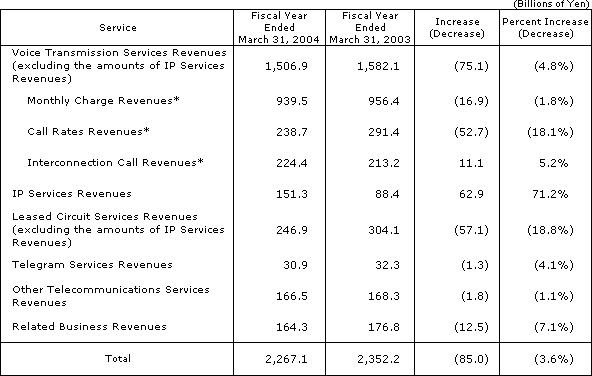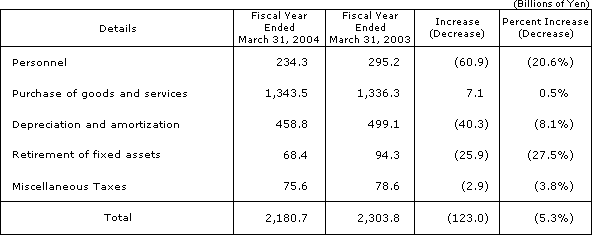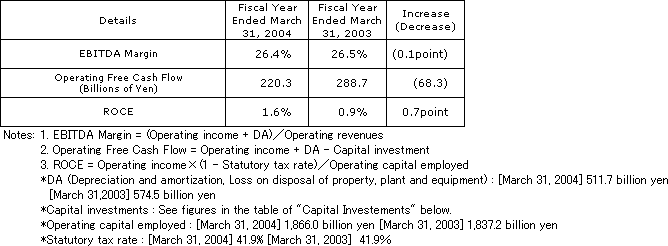Non-Consolidated Financial Results
for the Fiscal Year Ended March 31, 2004
April 1, 2003 - March 31, 2004
(Based on accounting principles generally accepted in Japan) |
[Operating Results]
![[Operating Results]](image/040514_8a.gif)
| Notes:1. |
Extraordinary profits for the fiscal year ended March 31, 2004 are gain on sale of property, plant and equipment. |
| 2. |
Extraordinary losses for the fiscal year ended March 31, 2004 are amortization of cumulative effect of change in accounting standard for severance payments and pension plans. |
[Proposal for Appropriation of Unappropriated Retained Earnings]
![[Proposal for Appropriation of Unappropriated Retained Earnings]](image/040514_8b.gif)
[Forecasts for the Fiscal Year Ending March 31, 2005]
![[Forecasts for the Fiscal Year Ending March 31, 2005]](image/040514_8c.gif)
[Breakdown of Operating Revenues and Operating Expenses]
(1) Operating Revenues

* Partial listing only
| Notes:1. |
"Voice Transmission Services Revenues" represent the total of telephone revenues and ISDN revenues. |
| 2. |
"Voice Transmission Services Revenues" for the fiscal year ended March 31, 2004 includes 18.2 billion yen in settlement of interconnection charges based on the LRIC methodology. |
(2)Operating Expenses

| Notes: |
"Purchase of goods and services" for the fiscal year ended March 31, 2004 includes a subsidy to NTT West of 18.4 billion yen. |
[Financial Position]
![[Financial Position]](image/040514_8f.gif)
* Partial listing only
[Cash Flows]
![[Cash Flows]](image/040514_8g.gif)
[Reference]
1. Number of Subscriber Lines

| Notes:1. |
"Number of Telephone Subscriber Lines" is the total of individual lines and central station lines (Analog Lite Plan is included). |
| 2. |
Since, in terms of number of channels, transmission rate, and line use rate (base rate), INS-Net 1500 is in all cases roughly ten times greater than INS-Net 64, one INS-Net 1500 subscriber is calculated as ten INS-Net 64 subscribers (INS-Net 64 Lite Plan is included). |
2. Number of IP-related Services Subscribers

3. Indicators

4. Number of Employees

5. Capital Investements

|
|

